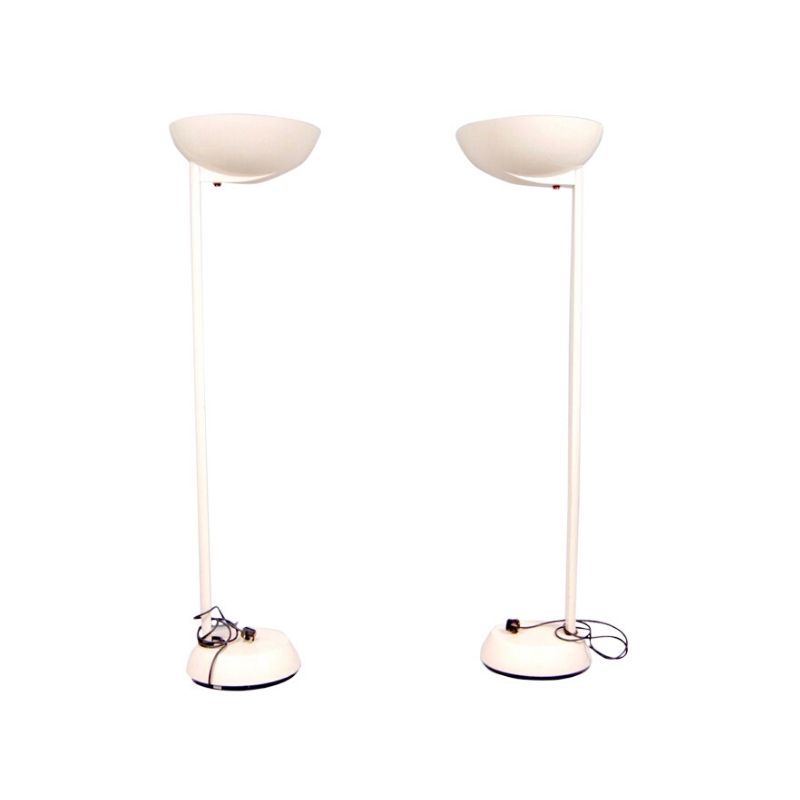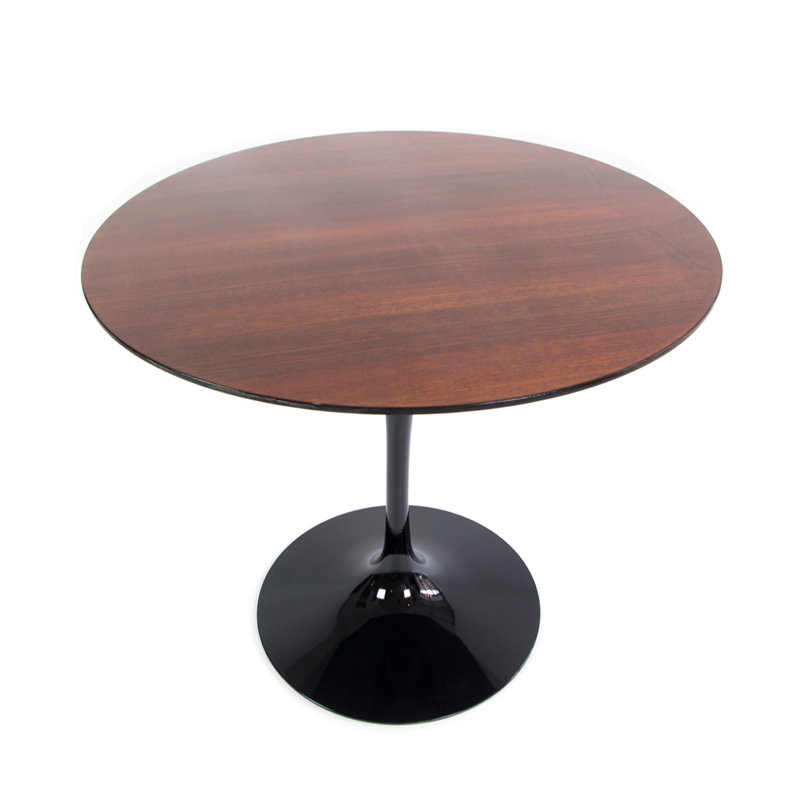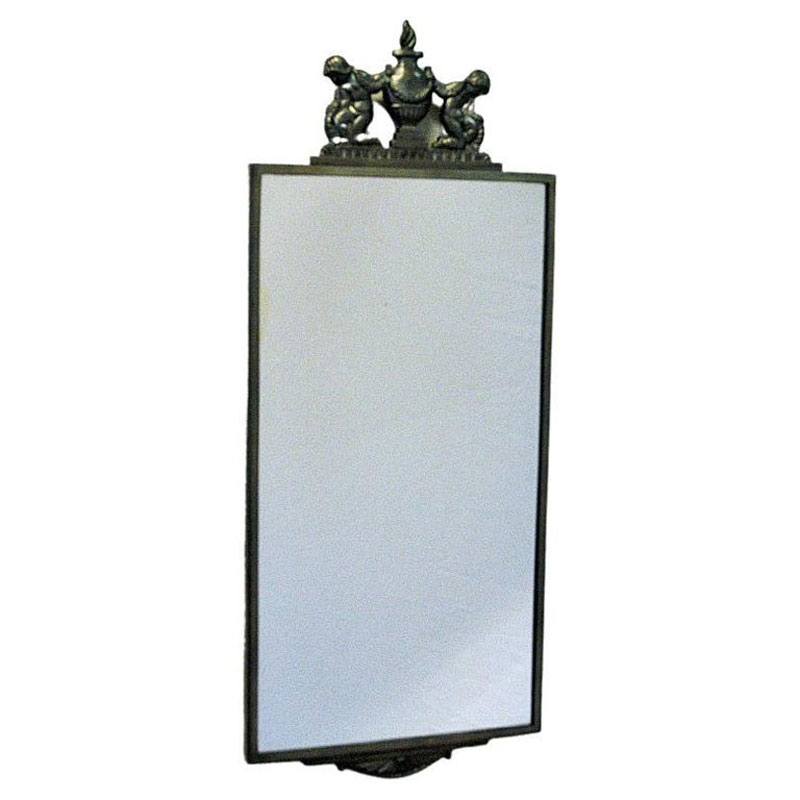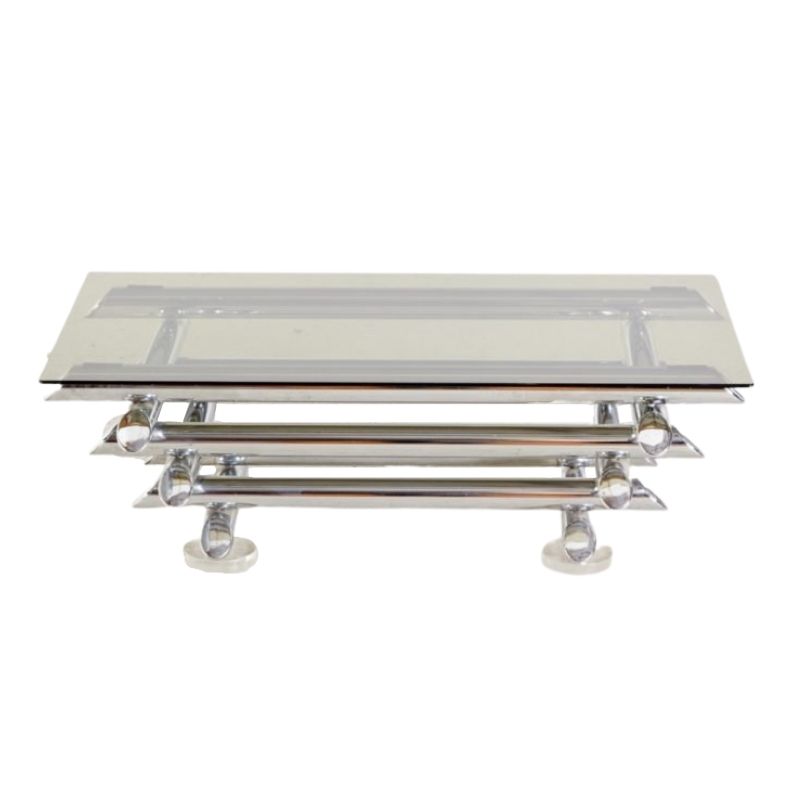Okay, why does this apparently rather simple and ordinary credenza, or cabinet, or whatever it is, look so unsual? What was Wegner doing with proportions, or whatever aesthetic tricks he might have been using, to make this look like no other Danish Modern credenza I've seen. Every other Danish Modern credenza I've seen looks very rectilinear and horizontal and low. It is usually very deep front to back and so looks very horizontal and low end to end and front to back. And they all tend to have skinny, slightly conic shaped legs that make the piece look like it is a bit fragile. Oddly, the effect of these skinny legs does not truly make the credenza float in air, rather the horizontal massing of the credenza usually visually overwhelms the skinny legs and the resulting effect is to make the typical Danish Modern credenza kind of hug a flat floor the way Philip Johnson's glass house hugs the ground, even though it has an airey space between floor and ceiling.
Wegner, on the other hand, creates an utterly different effect. He makes his piece much more shallow front to back, so shallow that its obviously taller than it is deep. And instead of using skinny, slightly conic legs, he uses thick, cylinders attached to obvious cross pieces that in turn appear to carry the credenza kind of like a wooden coffin from an old movie western resting on carrying poles. In fact the whole piece reminds me vaguely of what a really nice Danish Modern coffin might look like, if such a thing existed. Relating it to a coffin is not to suggest that it is depressing piece of furniture. Rather, I don't know what else to relate it to. This piece seems fantastically sophisticated in effect in visual effect. And I'm not suggesting Wegner was punning on coffins. Its just such a powerful, archetypal design, I think it dredged that image up in me coincidentally (probably saying more about my present state of mind that about Wegner or his furniture). But it still seems a remarkable piece of work to me, at least as different from other designers' crendenzas as his chairs are from others' designers' chairs. Did Hans just like to screw with everyone's senses from time to time? 🙂
Ehhrm phew wow oohh eehhrmm
Well where the hell to start apart from the obvious in relation to the cabinets looks and less to the state of wegner wanting to screw with minds let alone give coffin appeal to furniture.
Firstly the looks of wegners furniture can be simplified to take away what is not needed while keeping the strenght and looks of a design.
The combination of materials and the contrasts acheived by them is more the source of wegners desire with this cabinet.
As a owner of the said same cabinet (bought 10 years ago) the first to be said is that the RY100 series which this cabinet came from was a complete living room style which took the use of split cane / oak and teak and mixed them together.
All the 100 series has the teak base on each leg/ plinth etc to add colour into what is essentially a pale piece.
The use of the split cane with its depth perception and myriad of lines was again to break up what would be a solid plain looking face.
So in terms of the dimensions it comes back the point Wegner made that you should take away what is not needed.
The cabinet is dimensionally "busy" but the solid appeal of the legs comes in contrast to the delicate nature of split cane.
Form and Function is very much the spirit of this cabinet.
Simon
Simon...
Thanks for taking a crack at it. Your comments about the cane are partially helpful.
Frankly, though, I'm trying to understand the full combination of aesthetic techniques applied to create the visual effect. How exactly do the proportions and materials and atypical legs (at least for most Danish Modern) he chooses trick the eye into seeing this piece so differently than most other cabinets like it.
Maybe this articulation will clarify it: Wegner "removes" from every design to get to its essense. This process of removal strips away distractions and dilutions of the affect he is trying to create. What I'm fundamentally interested in is how he creates the visual effect that the stripping away permits one to experience with greater purity and robustness.
Past DA posts and responses have helped me already understand how the magician gets me to concentrate on the illusion (i.e., removing the nonessential). What I'm trying to learn is how he creates the illusion that he has gotten me to concentrate on.
Care to dig in a little deeper? I am eager to learn this. I suspect Koen knows the answer, too. He's just making me go begging. 🙂
dc
We had that exact credenza in the ZBT fraternity house,
i have not seen that piece of furniture since 1969 at that time i always thought that it was small and sat low and was against a window
Thanks for putting it up i never knew
That it was a Hans Wagner but it was bought in the early 60s and at that time i doubt that one member in that house could either identify that it was a Hans Wagner or could have cared less back then. amazing what over 40 years will put you,
Great recollection, LRF...
Thanks for sharing it. Its interesting how often there is some unknown person in the background of organizations large or small that makes some tasteful choices for the rest of us that we do not fully appreciate until long after. Some alum in ZBT knew something about design way back then and was going to introduce some civility to the group without making a big deal about it.
Koen...
So...you do actually sleep. Ah, that makes me feel better. I have worried that you have actually designed a way to avoid sleep.:-)
Regarding the trench, pleeeeeease tell me you were using a trencher and not a hand shovel!
Its okay for me to be out smashing my fingers with hammers building wooden gates out of 2x4 scrap from the lumberyard, as I am not being kept away from meaningful design work, but you...well, i'm going to have to, as my grandmother used to say, take a switch to you, if you don't get back to making beautiful, useful things right away.
Well, at least
he's not a concert pianist endangering his fingers ? Of course, Koen probably plays piano, too ?
Talk about "digging in a little deeper". . .! Have a good night's sleep .
In re LRF's note, I recall a pencil drawing made one night at the new women's dorm lounge at RISD, c 1961. A random group of Wegner's most famous chair caught my eye -- though I believe at the time I didn't know what they were. Quite a nice amenity for a bunch of art students to sprawl in. . .?
dc wilson
Some alum in ZBT knew something about design way back then and was going to introduce some civility to the group without making a big deal about it. Never a truer statement the original Pi lamba Phi house was one of the finest designed houses in the country in was built in 1961` and burned to the ground in 1963 never to be replaced. The fraternity got mad and disaffiliated and the fraternity was renamed for a short time to Phi Beta Delta and then changed to Zeta Beta Tau. They had some very unusual furniture but no one paid any attention to it they were to busy throwing up or smoking dope on it, such a pity . In Retrospect I remember lots of dcw/lcw chairs and round tables by Herman miller in the study hall . If only we knew,
Alright, Koen...
I posted the credenza picture with your cryptic geometric overlay hinting at a combination of Free Masonry, Rosicrucianism, Black Jesuit, and da Vinci Code conspiracy symbolism, and I trust that within its angles and forms lies a profound explanation, but...I am not able to glean it without your promised assistance. 🙂
Hi DC
I could not get the picture you posted on my screen and so I concluded that it would not serve much of a purpose to use it in my "analysis". But if I am the only one that does not see the picture I am very sorry for not reacting as promised.
What the lines show is basically the way Wegner "build" the proportions of this credenza. The front is a combination of two rectangular frames that are both double squares. A simple and often used proportion in mid century furniture. The most commun ways to support this "box" is to either put the legs at the very end. It's a solution that you find most often in either Swedish or Dutch furniture of that time. It has a "rational" look that fits the culture of both these countries. In the more purist dutch tradition it often is a metal frame. The reason is simple. If the panel thickness of the box is visible, as in this case, a wooden leg would be wider than that panel. In other words it would not line up. An easy way to solve that is to choose a stronger material like square steel tubing. The more "mechanical" solution both popular in Germany and Denmark at the time is to put the legs where they belong from a point of view of structural mechanics. Meaning lined up with the middle of each sliding door. Several Danish designers in cluding Wegner found that solution too "elegant" It makes the box float like a bridge segment. Wegner was in many ways a "down to earth" person and he liked a piece of furniture to stand the way an opera singer stands (virtually pushing his feet into the ground. Wegner could have put the legs in the axis of the 1/4 of the door width. (see drawing) He does not because he is a well educated designer and he knows that you have to look at both negative and positive space. So...first he has to decide the height of the legs. There again the simple solution is to repeat either the height of the door (far too high) or a simple division of it. He choses to make them half the height of the door. Being well educated he understands that because of the volume of the box, half the height will look less than half and so as an indication that the rational step is 1/2 the height he decides to show that he made in fact first a rational decision and than a visual correction. To express that he colours the added height (visual correction) black.
Now he goes back to the negative space on the outside of the legs. Why the outside, because the space between the two legs is wide and low and is not recognizable as a particular proportion. whereas the outside of the leg is so close to a square that making anything else but a square would "annoy" the eye. So having lifted the box slightly (by the height of the black part of the legs) he moves the legs inward by the same distance, creating a square proportion on the outside of the legs.
cont.
He then refines the detail by using the length of the leg to position the low end of the grip in the doors making a well balanced "Z" with the leg the horizontal part of the box outside the leg and that part of the frame that ends visually under the grip. Looking for self evident solutions more than for elegance he also decides to avoid such sophistication as 45 degree joints in the panels of the box. In traditional woodworker's tradition he continues the horizontal panels and put the vertical ones in between, no high flying joinery there. The woven structure of the doors is intriging. I suspect that he uses the "natural" look of thet weaving for two reasons. The first one is that it tends to make surfaces homogeneous. A typical wooden texture in a large surface like that would have a life of it's own. It is obvious that Wegner find this a distraction. The woven structure is also a relatively simple added value. It adds a "Craft" aspect to it that brings this very rational piece of furniture back into the "handmade" sphere of things.
Yes the whole thing looks self-evident and consistant with Wegner's vision of good craftmanship, down to earth and simple beauty...he just has a very sophisticated way to achieve it. I hope you understand that I will put as much thought in your garlic baker....
Koen,
a brilliant analysis. As Wright said of one of his biographers, "He knows more about me than I do !" I wonder if Wegner was as conscious of his methods as you are. . . (smily face)
I do particularly admire your pursuit of a plausible, perhaps even likely train of thought on his behalf. This is surely what makes the best criticism both entertaining and credible.
How many designers and artists have actually recorded their methods and intentions in these matters, I wonder. The analysis of the facades of Palladio and Le Corbusier (among many) seems to support such compositional strategies; I still have trouble believing that designers trust themselves so little to arrive at handsome proportions without the "aid" of numerical imperatives.
I certainly admit to being concerned with numerical regularity (ie, whole numbers rather than arbitrary [?] fractional dimensions) myself when designing. Perhaps I have been missing the obvious all these years. Are designers taught such strategies, do you know, or are they left to find them on their own ?
Now, if only there was a solution to the inevitable asymmetry of (an even number of) bypassing doors. . . !
With high regard, Stephen
I'm sure
I reveal only my own ignorance, not to say truculence, with the above; the worth (and the delight) of your analysis is self-evident. My innate scepticism (about things not sufficiently considered) will be my undoing. Stamping on the good work of others is beneath all of us, I would hope !
SDR
If you need any help, please contact us at – info@designaddict.com









